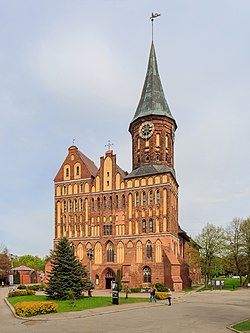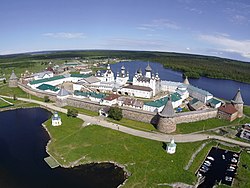Silver Ring is a collection of historical towns and cities in Northwestern Russia.
Understand
[edit]The Silver Ring tourism project was launched in 2012 to promote the cultural and historical centers of the Northwest of Russia. It includes temples, ancient churches, architectural types of the Northwest, the castles of the Novgorod Republic and the Teutonian Order, and Korela people's houses.
Prepare
[edit]See the travel warnings in our Russia article.
Get in
[edit]Saint Petersburg's Pulkovo Airport is the largest international Airport serving the Silver Ring region.
See
[edit]
- 1 Saint Petersburg — The city, which later became the capital of Imperial Russia, was founded by Peter the Great on the lands conquered from Sweden, and named after St. Peter.

- 2 Velikiy Novgorod — Novgorod was the capital of Rus' before it was moved to Kyiv (Kiev) in modern-day Ukraine. Founded in the 9th century. The main attraction of the city is the Novgorod Kremlin, in the museum of which birch bark letters are exhibited ), and on the Millennium of Russia monument you can see the main milestones in the history of the Russian state. Also popular among tourists are St. Sophia Cathedral, Yaroslav's Courtyard and Torg, Yuryev Monastery, Rurik's Settlement.

- 3 Staraya Russa (Старая Русса) — Staraya Russa was first mentioned in chronicles in 1167, but founded no later than the 10th century. From a cultural and historical point of view, the ancient settlement "Staraya Russa" (11th-14th centuries), the Transfiguration Monastery (12th century), St. George's Church (14th century) are of interest. Later buildings include the Trinity Church (17th century) and the Resurrection Cathedral (17th century).
- 4 Velikiye Luki (Великие Луки) — the first mention of Velikiye Luki in chronicles was in 1166. The city stands on the Lovat River, along which the route from the Varangians to the Greeks ran . The city was subjected to devastating invasions of the Livonian Order and the Polish troops of False Dmitry II. For this reason, little remains of the old architecture.
- 5 Porkhov (Рърхов) — in 1239, Alexander Nevsky with his retinue cut down a fortress on the Shelon River to protect against the Lithuanians. In 1387, on the site of the burnt wooden fortress, stone walls were built from flagstone. Today the fortress works as a museum. The walls themselves, three towers and the church of Nikola inside remained from its architectural ensemble. Speaking of churches. They are here, despite not the most advanced age, special. For example, the Church of the Nativity of the Blessed Virgin Mary looks like it was built in the first centuries of our era. Although in fact it was founded in the 14th century. But the point is not only in its dilapidation and lack of restoration makeup. The very silhouette of the shrine is more like southern Byzantine churches than classical Orthodox monasteries. No onion domes, bell-shaped candles or flat trapezoid belfries. No fancy galleries. Everything is simple, sometimes even gloomy.

- 6 Pskov (Псков) — the first mention of Pskov was in the Laurentian Chronicle for 903. The city was an important outpost on the western borders of Russia, having extensive defensive fortifications, the core of which is Krom. The main attraction of the Kremlin is the Trinity Cathedral. The Spaso-Preobrazhensky Mirozhsky Monastery (12th century) and the Snetogorsky Monastery (13th century) are considered to be the most ancient monuments of history and culture.

- 7 Izborsk (Избо́рск) — once one of the oldest cities in Rus', now a village. According to legend, it was founded by Slovene the Old in the 9th century. The city got its name Izboresk during the reign of Izbor, the son of Sloven.

- 8 Pechory (Печо́ры) — according to the chronicle, in 1392 two hunters from Izborsk stumbled upon the caves, over which the Assumption Church was erected in 1473. The main attraction of the city is the Pskov-Caves Monastery.

- 9 Kaliningrad (Калининград) — Kant Island Kaliningrad (until 1946, Königsberg) is a former Prussian city that became part of Russia following the Potsdam Conference (1945). The city was founded in 1255 by the Teutonic Knights. The architecture of the city was badly damaged during the Second World War: from the British bombing (August 1944) and the assault by the Red Army (April 1945). The main attractions are the Cathedral and fortifications preserved in the old city.
- 10 Ivangorod (Ивангород) — the city was founded by Prince Ivan III of Novy Selo on the Narova River in 1492, opposite the Teutonic Order Hermann Castle in Rugodiv . The purpose of building a fortress literally a hundred meters across the river from the Teutonic castle was to protect the Novgorod land from invasions from its western neighbors. During the construction of the fortress, the architects took advantage of the geological feature: the walls were erected on the ledge of the Baltic-Ladoga Glint, which made its assault unpromising. The architectural ensemble of the fortress includes the Assumption Cathedral, St. Nicholas Church, the Kolyvan Gates, a powder pit, an arsenal, and 11 towers.

- 11 Kingisepp (Yamburg) (Ямбург) — the city of Yam (before 1703 Kingisepp had this name) began with the founding of the stone fortress of the same name by the Novgorod boyar Ivan Fedorovich in 1384. The fortifications were dismantled in the 18th century. In the 21st century, only ramparts and remnants of walls remained. In the absence of medieval fortress walls, the main attraction of the city was Catherine's Cathedral, built in the second half of the 18th century by decree of Empress Catherine II.

- 12 Vyborg (Выборг) — founded in 1293 by the Swedes. During its long history, the city managed to be part of the Kingdom of Sweden, the Russian Empire and Finland. Since the Winter War, the city became part of the USSR, and after Russia. In the city, the Vyborg Castle, the Round Tower, the clock tower of the cathedral of the 14th century, the Town Hall tower (1477) are interesting. On the outskirts of Vyborg there is a rocky landscape park Mon Repos, popular with residents and guests of the city.

- 13 Priozersk (Приозерск) — the history of the city begins with the Karela fortress on an island at the mouth of the river Uzerva. The first mention in the Novgorod Chronicle dates back to 1143. The first defensive fortifications were made of wood and built by the Karelians. Today's fortress was founded by Novgorodians at the turn of the 13th and 14th centuries, and in different years belonged to Sweden, the Russian Empire, and Finland. The city finally became part of Russia after the confrontation between the USSR and Finland in the Great Patriotic War.

- 14 Staraya Ladoga (Ста́рая Ла́дога) — Ladoga is known as a point on the trade route from the Varangians to the Greeks and as the burial place of Prophetic Oleg (according to the Novgorod Chronicle). The main building in Ladoga is the Staraya Ladoga fortress, located on the territory of the museum-reserve. Other sights include St. George's Church, the Church of Demetrius of Thessalonica (Staraya Ladoga), the mound - the grave of the Prophetic Oleg. Staraya Ladoga is also where Rus', the first Russian kingdom, was said to have been founded by Rurik the Viking in 862.

- 15 Vologda (Вологда) — it was first mentioned in chronicles in 1147. Under Ivan III at the end of the 19th century, it became a place of exile for famous personalities, under Ivan the Terrible - one of the most important transit centers for trade with Western European states through the Sukhona and Northern Dvina rivers. The fortress walls and towers of the Vologda Kremlin have not survived to this day, they were dismantled by the 1820s. Vologda is rich in temple architecture.

- 16 Tikhvin (Тихвин) — the first information about the Tikhvin Prechistensky churchyard (the settlement that preceded the city of Tikhvin) dates back to 1383. The main architectural and historical landmark of the city is the Tikhvin Assumption Monastery, founded in 1560.

- 17 Valaam Monastery (Валаамский монастырь) — it was founded by the monks Sergius and Herman in the early Middle Ages. During its history, the Valaam Archipelago belonged to Sweden (Vyborg Flax), the Russian Empire (Vyborg Governorate, the Finnish Governorate, in the Grand Duchy of Finland again entered the Vyborg Governorate), Finland (Vyborg Governorate), the Soviet Union (Karelian Autonomous Soviet Socialist Republic) and the Russian Federation (Republic of Karelia).).

- 18 Solovetsky monastery (Солове́цкий монасты́рь) — founded in 1436 in the lands of the Novgorod Republic by the monks Zosima and German. However, the first monastic settlement on the islands appeared as early as 1429. Its founders were Herman and Savvaty.

- 19 Kizhi Museum (Kizhi Pogost, Кижский погост) — on January 1, 1966, on the basis of the architectural ensemble of the Kizhi Pogost, the Kizhi State Historical and Architectural Museum was founded, where, in addition to the buildings existing in their original places, a large number of chapels, houses and outbuildings from Zaonezhye and other regions of Karelia were brought.

- 20 Malye Korely (Малые Корелы) — the museum was founded in 1964, 25 km from Arkhangelsk. Buildings for transportation to the territory of the museum were rolled out on logs, and then reassembled already in Malyye Korely.
Stay safe
[edit]Go next
[edit]See also
[edit]- The Golden Ring is a similar collection of historic towns northeast of Moscow.

